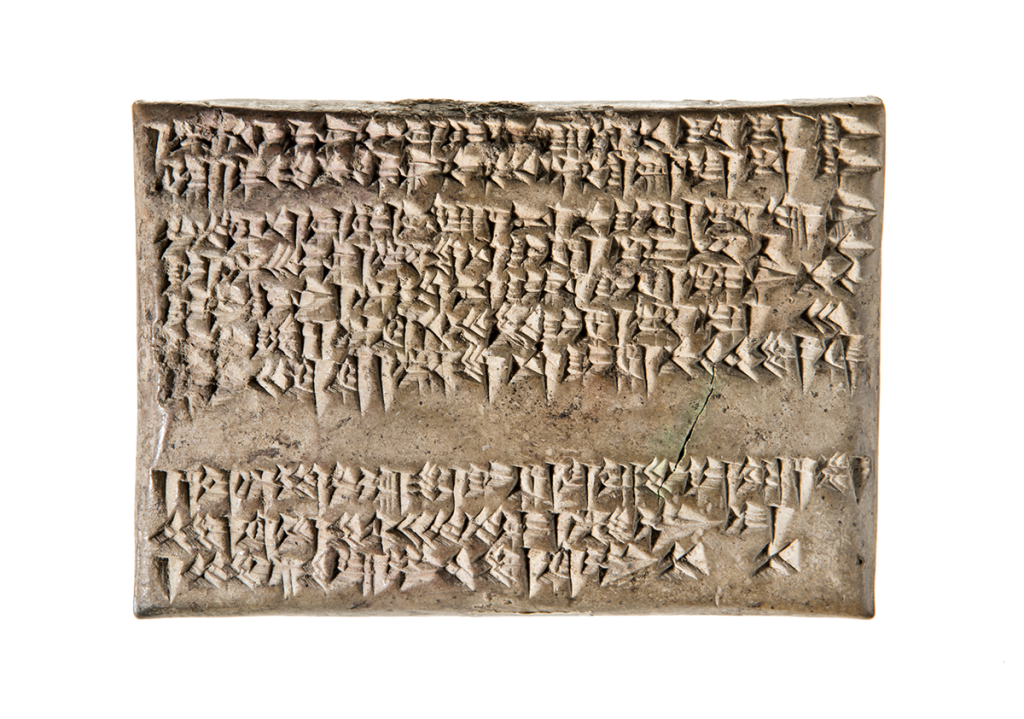The clay tablet LB 1326 made quite a journey from Babylon, where it was written in 529 BCE, via Berlin, to a collection of Near Eastern artifacts in Leiden, the Netherlands. This “adventure” is described below and may serve as an example of how texts from Babylonian archives can become scattered all over the world.
LB 1326 is one of the many clay tablets that belong to the de Liagre Böhl collection. It is a small legal document that was written in Babylon on the 20th day of the 12th month of the first regnal year of Cambyses (529 BCE). It belonged to the archive of the Nappāhu family. Luckily, the tablet has withstood the test of time very well so we can read it without too many difficulties. In this document Kaššāya, the daughter of Šumu-iddin of the Kutimmu family, recorded what she leaves to her two daughters after her death. The land that she owns will be divided among the two daughters. The older daughter, Ina-Esagil-ramât, receives a larger plot of land than her younger sister and a slave named Bēl-silim.
Let’s have a look where this tablet came from and how it reached the De Liagre Böhl collection. In 529 BCE the tablet LB 1326 was written in Babylon, in present-day Iraq, where it may have been deposited together with the other tablets belonging to the same archive around 484 BCE (see the ‘end of archives’ phenomenon). Since the tablet was written in Babylon, we may assume that it was excavated there, albeit in a clandestine excavation, possibly in the early 1880’s. In 1888 the Vorderasiatisches Museum in Berlin, Germany, bought the tablet that would later become LB 1326 together with many others. Like LB 1326, many of these also belonged to the archive of the Nappāhu family in Babylon. Note that at this time exporting and trading antiquities from the Middle East was still legal, but since the early 1970s it is forbidden. The museum in Berlin gave the tablet the museum number VAT 109, indicating it belonged to their collection. This number was written in ink on the tablet and is still visible today.
In 1936 Prof. F.M.Th. de Liagre Böhl wrote in a volume concerning his collection that he had bought LB 1326 from the Vorderasiatisches Museum in Berlin. According to Böhl the museum sold it because they were also in possession of a duplicate (VAT 110). Apparently they did not consider it necessary to keep both exemplars. After Böhl had bought the tablet, he gave it an LB number, indicating that it is part of his collection (LB = de Liagre Böhl). In 1951 de Liagre Böhl collection came in the possession of the Netherlands Institute for the Near East (NINO), which lent the tablet to the Rijksmuseum van Oudheden (Dutch National Museum of Antiquities) where it is currently on display as part of the permanent exhibition.
This small clay tablet, that fits in your hand, thus made quite a journey from Iraq, where it was deprived from daylight for almost 2,500 years, via Germany to the Netherlands.
Figure 1: LB 1326 Obverse and Reverse © National Museum of Antiquities, Leiden
529 BCE
Babylon, text written
484 BCE
Babylon, archive discarded? (end of archives)
1888
Tablet bought by the Vorderasiatisches Museum in Berlin, Germany, VAT 109
1936
Tablet in Böhl collection, Leiden, Netherlands, LB 1326
1951
Böhl collection, sold to NINO, Leiden, Netherlands, LB 1326
2015 until now
Tablet on display in Rijksmuseum van Oudheden, Leiden, Netherlands

Bibliography
- Baker, H.D. 2004: The Archive of the Nappāhu Family (Archiv für Orientforschung Beiheft 30), Wien, text no. 19.
- Böhl, F.M.Th. 1936: Mededeelingen uit de Leidsche Verzameling van Spijkerschrift-Inscripties, III: Assyrische en Babylonische oorkonden (1000-91 v. Chr.) (Mededeelingen der koninklijke akademie van wetenschappen, afdeeling letterkunde deel 82, serie B, No. 2), Amsterdam.
- Peiser, F.E. 1890: Babylonische Verträge des Berliner Museums in Autographie, Transcription und Übersetzung, Berlin, text no. 26.
Author: Lidewij van de Peut
Published on 29 November 2018


